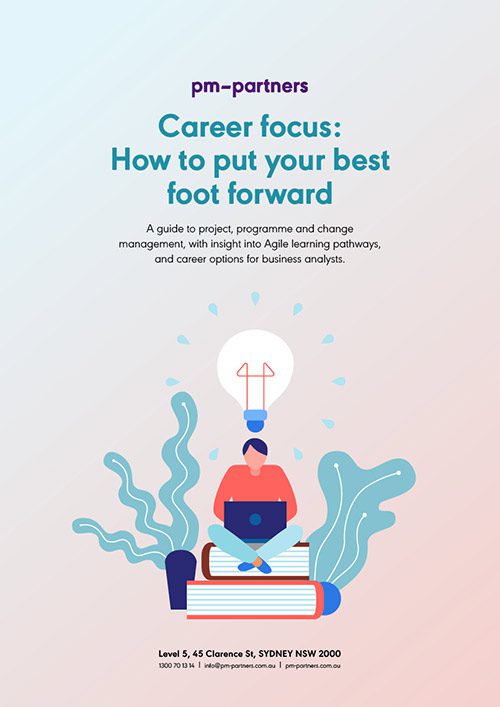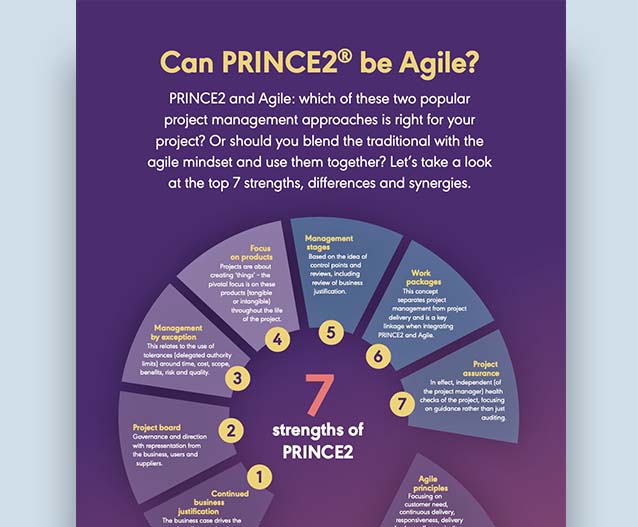
When the global pandemic hit in 2020, project professionals were forced to pivot, rethink, and adapt to survive. While some organisations took a moment to assess their portfolio investments, others seized the opportunity to shift their focus to being more agile.
With so much disruption and uncertainty, where does this leave the industry? How do young professionals, graduates, and newcomers enter into the field? And how do our seasoned project and programme managers excel in a world gone agile?
If you are unsure about what to do next, you’re not alone. Join us as we unravel the evolution of project delivery, from waterfall to global best practice framework PRINCE2®, to agile delivery methods and more. This guide is designed to help professionals decide which project management course, agile training, or other certification to consider in 2022.


When you think about the pyramids in Egypt it is easy to believe that project management has been around for millennia. After all, a project is simply a set of collective actions that has a start, a middle, and an end, and is designed to deliver an output. So one could argue that the Egyptians were actually running a programme, but that’s a conversation for another time. Let’s fast-forward from ancient Egypt to the ‘70s, as this is when project management courses, methods and techniques really began to take form.
First introduced as a method for software development, the term ‘waterfall’ became part of the project manager’s vernacular in the 70s. Essentially, it’s a traditional step-by-step approach to product development in which phases follow each other rigidly, with distinct goals for each phase of development.
After one phase of development has been completed, the development proceeds to the next phase and earlier phases are not revisited (hence the analogy that water flowing down a mountain cannot go back).

With waterfall, the emphasis is on upfront planning with the aim of gathering all requirements at the start of a project. Change is tightly controlled, and the value gained from the project is primarily delivered towards the end or after the project closes.
The term waterfall is often used interchangeably with the term ‘traditional’, in some cases to imply that this style of development is ‘old’ or ‘outdated’. But while waterfall does get more than its fair share of bad press, particularly with the rise of agile ways of working, it remains a tried and tested approach. Waterfall works extremely well in a predictable environment, for instance, in repetitive projects where procedures are already clearly defined, like construction.
Currently regarded as the world’s most practiced project management method, PRINCE2 was actually born from a private sector framework called PROMPT (Project Resource Organisation Management Planning Technique). Picked up by the UK government in the 80s to make IT projects more manageable, PROMPT was later adapted and given the acronym PRINCE, or PRojects IN Controlled Environments.
The new and improved PRINCE2 methodology arrived on the scene in 1996 after extensive expert consultation. Unlike its parent model, PRINCE2 was a generic project management method that was both robust and flexible and could be applied to any project regardless of type, sector or industry.
Over the years, PRINCE2 has developed a common international language for project management, with certifications (from AXELOS) held and used in 220 countries. Offering a structured approach and clearly defined principles, themes and processes, it has become a proven way of enabling successful projects from IT and product development to marketing and business transformations. But, the true power of PRINCE2 lies in tailoring the method to suit the specific project environment and the size, complexity and risk of the project.
FUN FACT
The PRINCE2 certification course has remained in PM-Partners’ top 3 most popular project management courses for over a decade.

Myth vs. reality
While waterfall and PRINCE2 are sometimes grouped together in the same ‘traditional’ bucket, it’s important to point out that the two are distinctly different.
PRINCE2 is a project management method (and certification) providing a proven framework and principles for enabling successful project delivery, whereas waterfall is a structured development approach.
PRINCE2 likes structure and it can be used in a waterfall way, just as agile ways can be blended with PRINCE2 (see PRINCE2 Agile® later), but it has never been a waterfall model and there is nothing in PRINCE2 which dictates a waterfall approach.


At the beginning of the twenty first century things were moving at lightning speed. The world was super charged with connectivity; we found Facebook, the iPod, and we learned to purchase online with Amazon. The rate of change had accelerated – customers wanted products and services faster, better, and more conveniently. Looking back, the time was clearly ripe for Agile to emerge.
The word agile is from the Latin word: to do. It embodies the concept of quickness, lightness and ease of movement. Born out of the desire to make software development more responsive to business needs, the Agile Manifesto was a pivotal point in the agile movement on its release in 2001. Two decades later, and you can safely say that it would be difficult to find a project professional without some element of ‘Agile’ experience on their resume.
But like all things project management, it’s not quite as clear-cut as that. There are multiple Agile pathways that one might choose and multiple definitions of what it means to take an Agile approach. In fact, Agile purists may even say that there is no project management in Agile, but this is not quite true.

Agile Project Management (AgilePM®) has been around as a framework and certification since 2010 and is designed specifically to help project managers within any industry or sector run projects in an agile way. Widely seen as a moderate form of Agile, it offers structure and a higher level of managerial control than some of the other Agile frameworks, with a focus on setting up teams for success, while also encouraging flexibility and autonomy.
For organisations requiring standards, rigour and visibility around project management, AgilePM provides the ability to marry this with the faster pace of change and empowerment that is integral to Agile.
Like PRINCE2, AgilePM can be used across all types of projects, but where PRINCE2 focuses on project management only, AgilePM addresses both the project management component and agile project delivery, similarly to waterfall project delivery.
TIP: How to spot the difference
in project delivery methods
Scope expectation is a simple way to explain to stakeholders and product owners that there is a fundamental difference between waterfall and agile. In waterfall, scope is fixed and protected. If you want more or less then you use a change request. In Agile, scope is agreed by prioritisation at a high level and can change through iterative sprints. The methodologies differ and you must change your mindset to deliver in either way.

One option for organisations with a strong history in waterfall that believe an ‘all-in-Agile’ approach may not fit across their organisation, is PRINCE2 Agile a project management course offering a blend of both worlds.
AXELOS released PRINCE2 Agile in 2015 to provide guidance on how to apply agile approaches – and the flexibility and responsiveness they offer – within the established governance framework of PRINCE2. Separately they have their own strengths, but when blended they offer the potential for a more holistic approach. View the PRINCE2 Agile course outline here.
PRINCE2 Agile is the only Agile project solution encompassing the full spectrum of Agile methods and frameworks. In effect, PRINCE2 Agile is agnostic; it does not favour one agile way over another. Practitioners can engage with Agile in all forms from Adaptive Software Development (ASD) to eXtreme Programming (XP) and everything in between.
With interest mostly to those who have Agile experience and are looking to adopt an industry standard in project management, PRINCE2 Agile is also gaining favour among ‘traditionalists’ looking to understand agile delivery methods, including how they can be utilised and how a project manager can collaborate with people in agile roles.


We’ve learned that the Agile methodology can be applied to project management, but if being an Agile project manager is not right for you then you are probably going to be more interested in part three. Here we discuss roles within Agile delivery teams, and we review agile frameworks, including the Scaled Agile Framework® (SAFe®)
Scrum is a popular way of applying the Agile methodology to everyday processes, particularly when developing and sustaining complex products. Created by Schwaber and Sutherland (c. 1995), the framework offers a collection of roles, events, artifacts and rules, providing a way to assess the efficiency of practices so that you can improve. Scrum was formulated as a faster, more flexible means of delivering the greatest value in the least amount of time.

Instead of a project manager, it’s typically the Scrum master (SMC® course) and Scrum product owner (SPOC® course) who are responsible for guiding and empowering a Scrum team. Both roles require a different skill set and have different attributes to a project manager and their own distinct set of accountabilities. As a quick rule of thumb, the key differences are as follows:
- Project managers are focused on delivering outputs within the constraints of time, cost and scope
- The Scrum master is a servant leader and takes on more of a facilitative role in the creation of the project's deliverables
- The Scrum product owner is responsible for maximising business value for the project and acts as the voice of the customer
The Business Analyst (BA) is a critical role within any project environment, including Agile. Business strategy execution depends upon developing and implementing solutions that provide demonstrable value to an organisation. Optimal value, however, can only be realised when solutions are based on precise requirements that fully address an issue or opportunity within the context of the ‘whole organisation and environment’.
Traditional BAs are aligned with A Guide to the Business Analysis Body of Knowledge® (BABOK® Guide), current research, and best practice industry standards. In contrast, an Agile Business Analyst (Agile BA) be versed more around the organisation's adoption of Agile approaches. BAs performing an Agile role need to have the necessary skills and expertise to provide value to the project outputs.

There are a few enterprise Agility options which have a proven track record for success – Scaled Agile Framework® (SAFe®), Large-Scale Scrum (LeSS), and Disciplined Agile Delivery (DaD). Below we discuss SAFe in more detail.
Scaled Agile Framework (SAFe) is an approach to implementing Agile into daily operations; promoting alignment, collaboration, and delivery across large numbers of Agile teams, applying a Lean approach to product development and systems thinking.
The word ‘scale’ is used when speaking about the Scaled Agile Framework (SAFe) as it was designed to support organisational growth by scaling with a structured approach. There are four configurations in SAFe to accommodate the various levels of scale: Essential SAFe, Large Solution SAFe, Portfolio SAFe, and Full SAFe.

If you are a mid-level Agilist (or of equal experience within an Agile environment) looking to develop your career within an agile world, then this is a good one to include in your tool kit. Leading SAFe® is about how to lead a Lean-Agile enterprise by leveraging the Scaled Agile Framework (SAFe) and its underlying principles. Courses cover topics like how to build and support Agile teams and programs, empower a lean portfolio, build a continuous delivery pipeline and DevOps culture, and how to coordinate large solutions. Formalising your skills with a Leading SAFe certification will grant you a SAFe Agilist (SA) title.


For those more seasoned professionals, you may have already earned your stripes within the industry as a senior project or programme manager. Perhaps you were working within an organisation that embarked on an Agile transformation and now you’re a seasoned Agilist. Either way, you’ve made it this far so kudos to you!
But what’s next? You can’t simply stand still.
Just like any organisation, you must prepare for change in order to remain competitive and stay in business. After all, you are your own success story.
Customer story: Listen to Dominic Cain speak about how he went from being a young Chef to a Programme Director.
Programme management is a vital component in the delivery of strategic business initiatives and change. Delivering the right benefits and outcomes from change requires a structured framework to coordinate, communicate, align, manage and control the activities involved.
Programme management provides this framework through organisation, processes, inputs, outputs and a focus on strategic thinking. Here are three options to consider if you’re looking to advance (or formalise) your programme management, or change management career by gaining certification.
Global best practice standards for programme managers:
Managing Successful Programmes (MSP®) represents proven good practice in the delivery of transformational change through the application of programme management. In today's climate of constant and rapid change, organisations have learned how to transform themselves through effective leadership and strategic control and by doing so they are more likely to survive and prosper
The MSP® 5th edition course offers an established best practice programme management framework, designed to align programmes and projects to organisational strategy and enable enterprise agility, focussing on the delivery of outcomes of benefit, while mitigating risk and actively engaging stakeholders.
The Agile Programme Management (AgilePgM®) course was developed in partnership with the Agile Business Consortium, AgilePgM® teaches participants a disciplined but flexible Agile approach to the management of transformational change in organisations, allowing for iterative and incremental delivery of outputs and benefits.
The governance model, contained within the guidance enables professionals to play a crucial role in ensuring a programme captures its vision, whilst empowering teams to work without undue interference. Built on firm foundations, the programme can evolve and react to business change in our increasingly dynamic world.

Change Management Body of Knowledge (CMBoK). One of the challenges facing organisations today is how to modify the business through regular change initiatives, with minimum disruption and maximum gain. The Change Management Foundation to Practitioner course is the definitive certification for professionals dealing with organisational change, transition and transformation. The course is based on The Effective Change Manager's Handbook.
Research suggests that 70 per cent of projects fail to secure their anticipated benefits because organisations install new systems, processes or practices, but are unable to implement the change fully: people are not sufficiently equipped for, or committed to, the new ways of working to sustain them. This demonstrates an obvious need for professionals to supplement traditional project and business management skills with skills in change leadership.



So how does all of this information help professionals decide what they should do next? Which project management courses, or Agile methods are the right ones to learn. Let's recap to see if we can identify a pattern forming:
- Change is constant and continuous. What’s more, it is running at high speed.
- Traditional project delivery is still used today because it is proven to work.
- The Agile methodology continues to evolve with new roles and opportunities.
- Global best practice standards, such as PRINCE2, can work in harmony with Agile for a structured approach to product and project delivery.
- Programmes are increasingly made up of both traditional and Agile projects.
Given all this, we know that today’s delivery environments are multi-modal (or hybrid). We also know that the industry is moving at an unprecedented pace. So when we consider the future of project delivery, it’s safe to say that it’s no longer a case of traditional versus Agile, or which single method or framework to endorse. Likewise, your career options are no longer so linear – there are multiple pathways to choose from.
While we can’t tell you which pathway to take (at least not in this ebook), what we can say is if you really want to accelerate your career and excel at delivery, then our advice is to gain cross-functional skills.
What do we mean by cross-functional skills?
If you're an Agile professional take a Project Management Fundamentals course, or learn about PRINCE2. Equally, if you are part of a traditional or PRINCE2 team, take the time to learn Agile; understand the foundations with a course like Agile Fundamentals, or AgilePM. Knowing and understanding how to do both will only boost your ability to deliver better outcomes, and potentially outperform your peers, getting you closer to achieving your professional goals.
From waterfall to Agile, projects to products, PMOs to Lean Portfolio Management, and business analysis to change, our expert team helps to deliver your outcomes more effectively, through advice, delivery teams, and upskilling your people to deliver better. Contact us today for a free consultation 1300 70 13 14.













